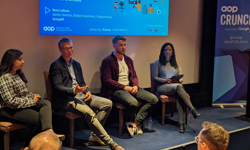I often introduce the company I work for as the biggest B2B publisher you’ve never heard of. Fact is, even if you have previously come across California-based Advanstar Communications Inc, you might not recognise it these days. Like most B2B publishers, Advanstar has gone through some huge changes in recent years.
Advanstar is a pretty sizeable business as B2B publishers go, with 55 publications, 150 conferences, 50 tradeshows and 250 electronic properties. It used to be bigger, at least in terms of the markets it served and the number of titles it published, but back in April 2005, the business sold off a range of magazines, events and digital properties in five non-core markets.
The divestiture raised $185 million and marked the start of a process designed to transform a traditional B2B publisher and tradeshow producer into a market-focused media business, leveraging the company’s strongest product positions to achieve long-term sustainable growth. The strategy worked well and two years after the business consolidated down to focus on three core sectors - Fashion, Powersports and Life Sciences - it was acquired by an investor group led by Veronis Suhler Stevenson for $1.142 billion in cash.
The recession and the accompanying downturn in business-to-business advertising made it harder to deal with the debt that underwrote the acquisition, but in 2009, management reached an agreement with investors to eliminate approximately $385 million in debt and inject $35 million in new capital. Contrast this with the fortunes of many other B2B publishing companies at the time: Questex, the company that bought Advanstar’s non-core titles back in 2005, filed for Chapter 11 bankruptcy protection in May 2009.
A major strategic realignment has run alongside the debt restructure, designed to deal with more testing economic conditions, but also to address the structural changes affecting the B2B publishing and events sector.
Cost control
Looking to improve operational efficiencies, Advanstar has outsourced production operations to HCL Technologies in India and worked hard to eliminate duplication of effort across brands and geographically. The European operation has managed to increase productivity and margins every year for the past three with a good old-fashioned mix of cost control - renegotiating print and distribution contracts, moving into smaller premises – and by tapping into US-based resources to remove duplicate headcount.
On the productivity front, the business is investing, group-wide, in technology for process integration. The first step was the adoption of the Censhare production management platform to streamline workflows with outsourced print production. Phase two will upgrade the current proprietary CMS to an open-source platform that will give editors more direct control of the digital publishing process. We are looking at the Drupal CMS in conjunction with Alfresco to handle asset management across print and digital.
In my own role, as head of content for the Pharma-Science group, we have restructured content creation and management operations to control costs, but also to maximise the domain knowledge that we have and make it easier to service audiences across multiple platforms.
Multi-platform outputs
Like every other B2B publishing house, our outputs have expanded exponentially over the last ten years. Back in the good old days, whenever they were, the Pharma-Science group put out ten or twelve monthly magazines and a series of supplements. Fast forward to today and we have the same number of magazines and a similar number of supplements plus websites, webcasts, newsletters, digital magazines, online communities and an e-learning service.
How do we manage this with less not more people? The biggest change has been to replace magazine-specific content staffs with global teams working across market sectors. For example, where we used to publish regional magazine websites, we now run global brand websites with staff either side of the Atlantic keeping content flowing through websites, newsletters and social media.
We cemented the international teamwork concept by organising our brands into four market groups – Science, Pharma Manufacturing, Pharma Business and Clinical Trials. Under a single editor-in-chief, regardless of location, each group shares domain specialists and editing and writing staff. This allows us to spread technical expertise across titles and smooth out the editorial workflow with teams taking advantage of breaks in the production cycle for one brand to focus efforts on another.
The content creation processes are also changing to reflect our audience’s appetite for multiple channels. Where our dominant focus was once peer-reviewed scientific articles produced on a monthly print cycle, we are now streaming social media and website content daily, newsletters weekly and webcasts on-demand.
Content lifecycle
It is becoming more and more evident that the secret to keeping all the channels ticking over is to publish throughout the content lifecycle. The old M.O. was to commission an article, wait a couple of months for it to be written, keep it in editing and production for another month then publish it. The audience knew nothing of the process until the words appeared on the page. Our ambition is to develop content packages that run from initial tweets exploring the viability of a feature, through public polling of the community, the release of interview audio clips, interim blog posts, features in print and integration of archive material online. The process is public and collaborative; the output is continuous across multiple platforms. Nothing gets wasted.
As the market changes, content staff are also working with advertising and sponsorship clients more closely than ever before to create content that will cut through the market noise and engage the audience at a much deeper level. Our educational webcast program is a strong example of this, where programmes built around topics researched and produced by the content teams pull significantly higher viewing figures than vendor-led programming that is overly promotional. We need to be careful around issues of editorial independence, but there is a strong belief that the best weapon in the sales manager’s arsenal is independent, credible content.
Community
Our relationship with our audience has also changed. Where our magazines were once built around the notion of the “Editor as Expert”, we now encourage our audiences to add their expertise and experience to the conversation. The best example of this is our analytical chemistry group’s community and its associated e-learning service.
The Chrommunity – currently on the Ning.com platform - is an online community of almost 4,000 chromatographers in 80-plus countries. They use the site to blog, share ideas, and ask and answer highly technical questions about analytical chemistry. This is a fantastic vehicle for us to feed through content from our magazines and newsletters, but also to promote subscriptions to our CHROMAcademy e-learning service, which is designed to educate scientists in the issues that are being raised by the community.
The project is collaboration between Advanstar and Crawford Scientific, a scientific training company based in Lanarkshire, Scotland, and is a classic Win-Win. Crawford has supplied over 3,000 pages of e-learning content, much of it animated in Flash, we have supplied contact with thousands of chromatographers and a sales resource.
Digital editions
Not every digital product we have launched has worked; putting revenue against digital magazines has been very difficult. Our replica editions generate very little revenue, although pushing them onto the iPad has given them a new lease of life. Our optimised digital editions, designed for the screen and featuring unique content, have fared better, and we have been reasonably successful in taking advantage of low digital distribution costs to create magazines with a truly global reach.
There are huge advantages in working for a bigger, multinational publisher; one of the benefits being that we have access to a lot of learning. Colleagues from our Kansas-based Veterinary group recently launched an iPad magazine with Pixelmags and we are talking with them to learn all we can before diving into a designed-for-iPad magazine project. But it took a trip to Kansas to establish the relationship and culturally, it can be a challenge sometimes to bridge the cultural gaps in a truly international team.
International operation
And we are truly international. Most of my staff are in America and most of the editors in Chester now have American bosses. Our production people are in Chennai and Noida in India and we have partners in Scotland and clients and readers all over the world. It takes patience and perseverance to make sure that everyone stays on the same page.
What next? Earlier this year, our Pharma-Science publications group merged with the CBI conference group based in Boston under the leadership of EVP Ron Wall, who came to us from Canon following its purchase by UBM.
This integration brings together our publications portfolio and audience of pharmaceutical and laboratory professionals with a schedule of 150 highly-specialised conferences tightly-focused on Pharma topics from “Strategic Distribution Planning” to “Quality by Design”.
B2B media’s challenge has always been to match actionable content with the right audience, and the more targeted we can get the more successful we can be. One of our biggest projects at the moment is to bring our publication and conference lists together to give us a potential list of over one million names and to develop the segmentation that will allow us to promote and deliver incredibly niche content alongside an equally specialised conference schedule.
The key to future success lies in evolving traditional product portfolios from straightforward marketing vehicles into multi-channel content platforms with increased audience and customer engagement and, ultimately, a focus on the facilitation of commerce. The transition is hard work, but without the change, the future would look a lot less bright.










